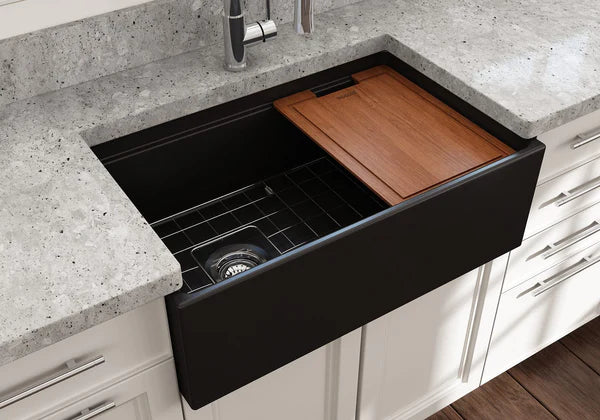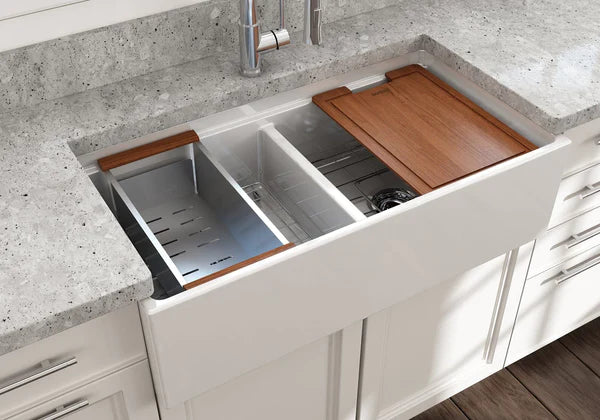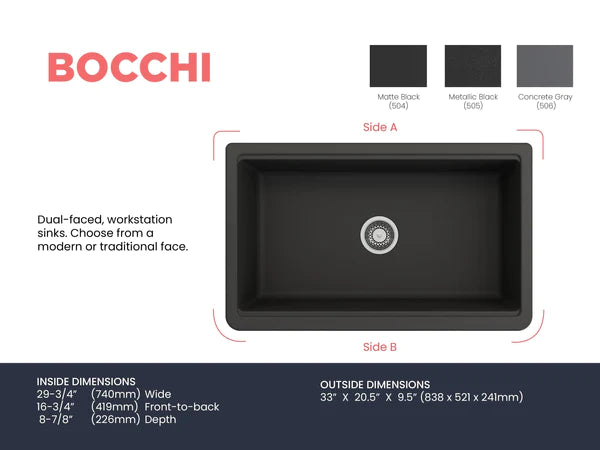The kitchen has seen numerous design and functional evolutions over the years. From the rustic stone basins of ancient times to the sleek stainless steel models of the 21st century, kitchen sinks have always been a vital component of any household. Traditionally, their primary role was straightforward: a place to wash dishes, rinse vegetables, and fill pots.
However, as our lives have become busier and our need for efficiency has grown, the demand for a more multifunctional kitchen space has risen. Enter the work station sink—a revolutionary concept that is redefining the very essence of kitchen functionality.
At its core, a work station sink is not just a place to wash dishes; it's a comprehensive work area designed to streamline kitchen tasks, optimize space, and enhance the cooking experience. This new trend is not just about aesthetics; it's about transforming the way we interact with one of the most used spaces in our homes.
In this guide, we'll delve deep into the rise of work station sinks, exploring their features, benefits, and the reasons behind their soaring popularity.
Historical Context
The kitchen sink, while often overlooked, carries a rich history that mirrors the evolution of domestic life and design preferences. Let's journey back in time to understand the progression that led to the emergence of work station sinks.
- Ancient Beginnings: The earliest kitchen sinks were rudimentary basins carved out of stone or made from clay. These were primarily outdoor installations, used in conjunction with a nearby water source like a well or stream. The primary function was simple: a place to collect water.
- Victorian Era Innovations: As plumbing systems became more advanced in the late 19th century, sinks moved indoors. The Victorian era saw the introduction of the butler's sink—a deep, rectangular basin made of fireclay. This design was both functional and aesthetically pleasing, fitting well with the ornate interiors of the time.
- 20th Century Modernization: The 1900s brought a wave of innovation. Materials like stainless steel and porcelain became popular, offering durability and ease of cleaning. The double-basin sink design emerged, allowing for a division of tasks like washing and rinsing. Faucets also saw upgrades, with features like sprayers for more efficient cleaning.
- Late 20th Century to Early 21st Century: As kitchens became more than just a place to cook—transforming into social and family gathering spots—the open-plan design gained traction. Sinks began to incorporate features like garbage disposals, and the island sink became a popular choice for its central location.
- The Need for More: Despite these advancements, a gap remained. Modern families sought a kitchen space that could keep up with their multitasking lifestyles. The need for a sink that could serve multiple purposes—beyond just washing—became evident. This set the stage for the birth of the work station sink.
The evolution of the kitchen sink is a testament to our ever-changing lifestyles and the continuous quest for efficiency and convenience. The work station sink, with its multifunctional design, is a natural progression in this journey, meeting the demands of contemporary life.
Features and Benefits of Work Station Sinks

The work station sink is not just a trend; it's a reflection of the modern homeowner's desire for a kitchen that's both functional and stylish. Let's delve into the unique features of these sinks and the benefits they bring to the table.
- Integrated Accessories: One of the standout features of work station sinks is the array of integrated accessories they come with. From cutting boards that fit snugly over the sink to colanders that slide seamlessly for easy rinsing, these accessories are designed to enhance kitchen efficiency.
- Multi-tiered Levels: Many work station sinks feature multi-tiered levels, allowing users to perform multiple tasks simultaneously. For instance, you can chop vegetables on the cutting board tier while washing dishes below.
- Enhanced Drainage Systems: Gone are the days of water pooling in the sink. Work station sinks often come with advanced drainage systems, ensuring that water flows away quickly, preventing residue buildup.
- Space-saving Benefits: For those with smaller kitchens, the work station sink is a game-changer. Its design maximizes space, reducing the need for additional counters or storage units. Every inch of the sink is utilized, making the most of limited kitchen real estate.
- Ergonomic Design: Work station sinks are often designed with ergonomics in mind. The depth, width, and placement of accessories are optimized for user comfort, reducing strain during prolonged kitchen tasks.
- Versatility: Whether you're a professional chef or a home cook, the work station sink caters to all. Its design is versatile, accommodating a range of culinary tasks from food prep to cleanup.
- Aesthetic Appeal: Beyond functionality, work station sinks are also aesthetically pleasing. They come in a variety of materials and finishes, from sleek stainless steel to elegant granite, ensuring that they complement any kitchen decor.
- Durability: Given their multifunctional nature, work station sinks are built to last. They are often made from high-quality materials that resist scratches, dents, and stains, ensuring longevity.
The work station sink is more than just a sink; it's a comprehensive kitchen solution. It amalgamates various kitchen tasks into one cohesive unit, streamlining processes and enhancing the overall cooking experience. For modern homeowners who value both form and function, the work station sink is the epitome of kitchen innovation.
Comparative Analysis
In the world of kitchen design, every element plays a crucial role in determining functionality and aesthetics. As work station sinks gain popularity, it's essential to understand how they stack up against traditional sinks. Let's look at a comparative analysis to discern the differences and advantages of each.
Design and Functionality:
- Traditional Sinks: Typically come in single or double basin designs. Their primary function revolves around washing dishes, rinsing food, and filling pots. Accessories like dish drainers or cutting boards are usually separate additions and not tailored to fit the sink.
- Work Station Sinks: Designed with integrated tiers and accessories like cutting boards, colanders, and drying racks. They offer a multifunctional space, allowing users to perform a variety of tasks simultaneously.
Space Utilization:
- Traditional Sinks: While they can be spacious, traditional sinks often require additional counter space for food preparation and other tasks.
- Work Station Sinks: Optimize space by incorporating multiple functions within the sink itself, reducing the need for extra counter space.
Cost Implications:
- Traditional Sinks: Generally less expensive upfront. However, when you factor in the cost of separate accessories and potential renovations for more counter space, the costs can add up.
- Work Station Sinks: Might have a higher initial investment due to their advanced design and integrated features. However, they can offer long-term value by reducing the need for additional purchases and maximizing kitchen efficiency.
Aesthetic Versatility:
- Traditional Sinks: Available in various materials and styles, but the design is relatively standard, focusing on the basin's depth and width.
- Work Station Sinks: While they also come in different materials and finishes, their design is more modern and streamlined, often becoming a statement piece in the kitchen.
Maintenance and Cleaning:
- Traditional Sinks: Simple design makes them relatively easy to clean, but separate accessories might require additional cleaning efforts.
- Work Station Sinks: Designed with ease of cleaning in mind. Integrated accessories often have features that prevent food buildup, and the enhanced drainage systems reduce water spots and residue.
Longevity and Durability:
- Traditional Sinks: Durability largely depends on the material used. Stainless steel and porcelain are common choices that offer decent longevity.
- Work Station Sinks: Given their multifunctional nature, they are often constructed with durability in mind, using high-quality materials that resist wear and tear.
While traditional sinks have served households faithfully for years, work station sinks represent the next step in kitchen evolution. They cater to the modern homeowner's needs, blending functionality with style. Whether you're renovating your kitchen or building a new one, it's worth considering the benefits of a work station sink and how it can elevate your culinary space.
Popular Work Station Sink Brands and Models

As the demand for work station sinks grows, several brands have risen to the challenge, offering innovative designs and features that cater to a range of kitchen needs. Let's explore some of the leading brands in the market and highlight their top-rated models.
Bocchi
- Contempo Apron Front Workstation: A fireclay sink with a modern twist, it offers a protective bottom grid and a deep bowl for versatile use.
- Vigneto Workstation: Combining elegance with functionality, this model features an integrated ledge system and comes with a range of accessories.
Ruvati
- Roma Workstation: This ledge sink is known for its sharp zero-radius corners, giving it a sleek modern look. It comes with a range of accessories, including a cutting board and a colander.
- Verona Apron-front Workstation: A unique blend of the farmhouse style with modern functionality, this sink offers two tiers and a variety of accessories.
Nantucket
- Professional Series Workstation: Nantucket's Professional Series brings an industrial edge to the workstation concept, typically featuring heavy-duty stainless steel construction, soundproofing technology, and an array of built-in accessories such as drying racks and cutting boards.
- Cape Collection Workstation: This series often includes a classic apron front design with a modern twist, equipped with a sliding dual-platform system for a customizable workspace that can accommodate a multitude of tasks.
Each brand brings its unique touch, ensuring that homeowners can find a model that perfectly fits their kitchen's aesthetics and functional needs. When considering a purchase, it's essential to research and compare different brands and models to find the ideal fit for your culinary space.
Installation and Maintenance

The allure of work station sinks lies not just in their multifunctionality but also in their ease of installation and maintenance. However, to ensure longevity and optimal performance, it's crucial to understand the nuances of setting up and caring for these modern kitchen marvels.
Installation:
- Professional vs. DIY: While many homeowners are tempted to install their sinks, it's advisable to hire a professional, especially if you're unfamiliar with plumbing. A professional can ensure proper alignment, secure fittings, and correct drainage.
- Undermount vs. Topmount: Work station sinks can be installed as undermount (below the countertop) or topmount (sitting on top of the countertop). The choice often depends on the countertop material and personal aesthetic preferences.
- Space Considerations: Ensure that the cabinet and counter space can accommodate the sink's size. Remember to account for additional accessories and the integrated ledge system.
- Plumbing Adjustments: Given the unique design of work station sinks, some adjustments to existing plumbing might be necessary. This includes ensuring proper drainage and accommodating any additional features like built-in garbage disposals.
Maintenance and Cleaning:
- Regular Rinsing: After each use, rinse the sink to prevent food particles and soap residue from building up. This simple step can prevent stains and maintain the sink's shine.
- Mild Cleaners: Avoid abrasive cleaners or scouring pads. Instead, opt for mild dish soap or a cleaner specifically designed for the sink's material (e.g., stainless steel or granite composite).
- Accessory Care: Clean integrated accessories, like cutting boards or colanders, separately. Wooden accessories should be oiled periodically to prevent drying or cracking.
- Prevent Scratches: While many work station sinks are resistant to scratches, it's a good practice to use protective grids or mats, especially if using heavy pots and pans.
- Addressing Stains: For stubborn stains, consider using a mixture of baking soda and water. Apply the paste to the stain, let it sit for a few minutes, then rinse.
- Drain Care: Ensure the drain remains clog-free. Regularly check and clean the strainer, and consider using natural solutions like a mixture of vinegar and baking soda to clear minor blockages.
While work station sinks are designed for durability and ease of use, proper installation and regular maintenance are key to ensuring they remain in pristine condition. By following the above guidelines, homeowners can enjoy the benefits of their work station sink for years to come.
Environmental and Sustainability Aspects

In today's eco-conscious world, the environmental impact of our choices, even those related to kitchen fixtures, cannot be overlooked. Work station sinks, with their innovative designs and features, also play a role in the broader sustainability conversation. Let's delve into the environmental aspects associated with these sinks.
Materials and Environmental Impact:
- Stainless Steel: One of the most common materials for work station sinks, stainless steel is recyclable, making it a sustainable choice. The production process, however, does have an environmental footprint, primarily due to mining and energy consumption. Choosing sinks made from recycled stainless steel can mitigate some of these impacts.
- Granite Composite: Made from a mixture of granite stone dust and acrylic resins, granite composite sinks are durable and long-lasting. The use of natural stone reduces the need for new raw materials, but the binding agents can have environmental implications.
- Fireclay: A type of ceramic, fireclay is made by molding clay and glaze together under high temperatures. While it's a natural material, the energy-intensive firing process can contribute to carbon emissions.
- Copper: Some luxury work station sinks are made from copper, which has natural antimicrobial properties. However, copper mining can be environmentally detrimental, leading to deforestation and habitat destruction.
Water-Saving Features and Benefits:
- Efficient Faucet Design: Many work station sinks come with faucets designed to optimize water flow, ensuring efficient rinsing and cleaning with less water wastage.
- Integrated Drainage Systems: The advanced drainage systems in these sinks prevent water pooling, leading to quicker and more efficient cleaning processes.
- Accessory Integration: The inclusion of colanders and other accessories directly in the sink can reduce the need for multiple rinses, conserving water.
- Deep Basin Design: The depth of work station sinks can hold more dishes at once, allowing for fewer washing sessions and, consequently, less water usage.
Sustainability Considerations:
- Longevity: One of the most significant sustainability aspects of work station sinks is their durability. A long-lasting sink reduces the need for replacements, leading to fewer sinks ending up in landfills.
- Recyclability: Choosing materials that are recyclable, like stainless steel, ensures that once the sink has reached the end of its life, it doesn't contribute to waste but can be repurposed.
- Eco-friendly Cleaners: Homeowners can further reduce their environmental impact by using green cleaning products for their sinks, avoiding harmful chemicals that can contaminate water sources.
While work station sinks offer numerous functional benefits, their environmental and sustainability aspects are equally noteworthy. By making informed choices regarding materials and maintenance, homeowners can ensure that their kitchen not only looks good but also treads lightly on the planet.
Conclusion: Work Station Sinks

The kitchen, often dubbed the heart of the home, has witnessed a remarkable evolution over the years. From being a mere functional space to becoming a central hub for family gatherings, culinary experiments, and social interactions, the modern kitchen reflects the changing dynamics of our lifestyles. At the forefront of this transformation is the rise of work station sinks, which are redefining the very essence of kitchen design.
As we look into the future of kitchen spaces, it's evident that adaptability, efficiency, and sustainability will be the guiding principles. Work station sinks, with their multifunctional design and eco-friendly attributes, align seamlessly with this vision. They encapsulate the essence of modern living, where every inch of space is optimized, every resource is utilized judiciously, and aesthetics and functionality coexist harmoniously.
For homeowners contemplating a kitchen renovation or those in the process of designing a new culinary space, the decision to incorporate a work station sink should be a no-brainer. Beyond the immediate benefits of enhanced functionality and aesthetics, these sinks represent a long-term investment in sustainability and convenience. They cater to the evolving needs of modern families, from the amateur cook experimenting with new recipes to the professional chef seeking efficiency in every task.
So, as you stand on the cusp of creating or reinventing your kitchen space, remember to consider the myriad benefits of work station sinks. Let them be the cornerstone of a kitchen that's not just about cooking, but about living life to the fullest.
Discover the epitome of work station sinks at Manor House Sinks - where design meets innovation.

